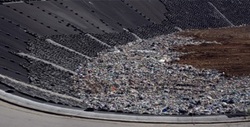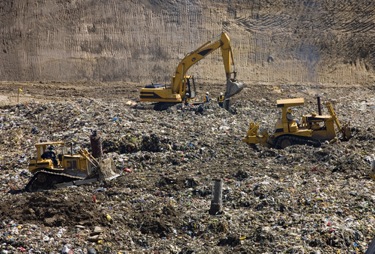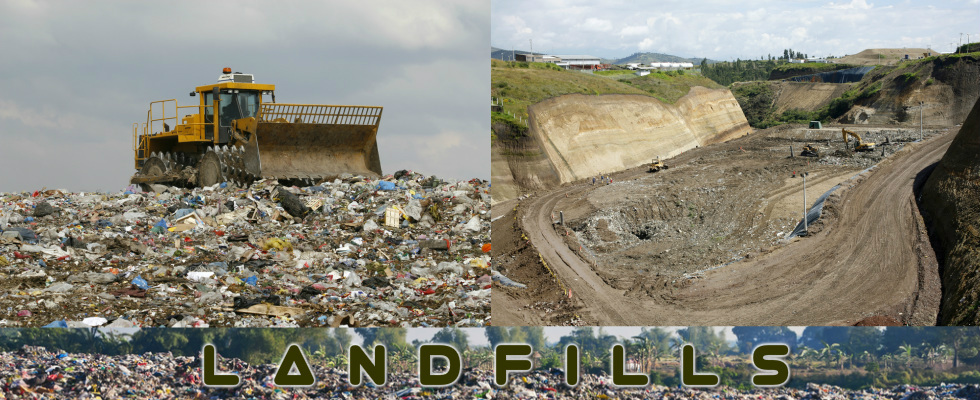
Landfills
Solid waste landfills play an important role in modern-day society and are indispensable for handling humanity's unprecedented rates of consumption, however, the adverse health and environmental effects of ever-growing landfills pose serious risks that are essential to understand so we may further acknowledge the importance of holding onto our items and reusing them as long as we can, composting, recycling etc. Americans generate trash at an astonishing rate of
4.43 pounds per day per person, which translates to 250 million tons per year. This is almost twice as much trash per person as most other major countries. Some of this trash gets recycled or composted, some gets incinerated but the majority is buried in landfills. Landfills are sites for the disposal of waste materials by burying them into the ground or less commonly, disposing of them on top of the ground. Secure landfills are
carefully engineered depressions in the ground
which aim to avoid any hydraulic or water-related connections between the waste and surrounding environment, especially underground, and consist of four critical elements: a landfill liner, which are only
1/10 of an inch thick, a leechate collection system, a cover, and a natural hydrogeologic setting. However,
leaks in landfills inevitably develop, potentially releasing toxic chemicals and gases.
Learn more.
"First, even the best liner and leachate collection system will ultimately fail due to natural deterioration, and recent improvements in MSWLF containment technologies suggest that releases may be delayed by many decades at some landfills. For this reason, the Agency is concerned that while corrective action may have already been triggered at many facilities, 30 years may be insufficient to detect releases at other landfills." ~ EPA Federal Register
Learn more.
Atmospheric Effects
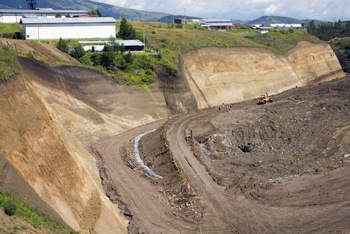
Landfill gases, which can seep through the soil into outdoor air and inside nearby buildings, are comprised of many different types of gases,
the majority being methane and carbon dioxide, which makes up to 90 - 98% of landfill gas.
The remaining 2-10% includes nitrogen, oxygen, ammonia, sulfides, hydrogen and various other gases.
Of the gases produced in landfills,
ammonia, sulfides, methane, and carbon dioxide are of most concern
and are certainly the most harmful as they contribute to
climate change, ground-level ozone, the displacement of oxygen and can even lead to high levels of methane, which is flammable,
creating explosive conditions in nearby buildings. According to
NYS Dept. of Health, these gases are produced when bacteria break down organic waste and the amount of these gases depend on the type of waste present in the landfill, the age of the landfill, oxygen content, the amount of moisture and temperature. Though the production of these gases generally
peak in 5-7 years, a landfill can continue to produce gases for more than 50 years.
According to the EPA, the methane produced by the rotting organic matter in landfills is 20 times more effective than carbon dioxide at trapping heat from the sun and estimates that
landfills account for 25% of all methane releases linked to human activity. However, methane is not the only gas that gets produced by the various forms of rotting organic matter that find their way into landfills. Household cleaning chemicals and e-waste toxins often
make their way into the landfill as well. The mixture of these chemicals can
produce toxic gases that can significantly impact the quality of air in the vicinity of the landfill.
Interest in the use of landfill gas to fuel electricity generation is growing.
Landfill methane is collected at a growing number of landfill sites and burned for energy production which mitigates the global warming effect of the methane as well as producing electricity.
Learn more.
Hydrological Effects
Landfills present
long-term threats to groundwater and surface waters that are hydrologically connected
by creating a toxic soup of industrial and home-cleaning chemicals. Containing everything from
industrial solvents to household cleaners, landfill chemicals accumulate and mix over time with precipitation that falls into a landfill, which
results in the extraction of the water-soluble compounds and particulate matter of the waste. This leads to the subsequent formation of leachate, also known as
"garbage soup", which is a
highly toxic liquid formed when waste breaks down in the landfill and water filters through that waste, which can pollute the land, ground water and water ways, presenting a major threat to the current and future quality of groundwater. Furthermore, electronic waste, which contains everything from
lead to cadmium, is also a large contributor to water quality issues near landfills. The
EPA reports
that in 2009, of the 2.37 million short tons of electronic waste, around 25 percent or less were recycled. These chemicals accumulate and are washed away periodically by rain, potentially dragging them toward
municipal water supplies.
The
release of hazardous and nonhazardous components of leachate
may present a danger to the environment and to aquatic species or other wildlife if the leachate-contaminated groundwater plume discharges to wetlands or streams and may render an aquifer unusable for drinking-water purposes and other uses. Although
many landfills are now constructed with liners that contain leachate and leachate collection systems that collect it, historically, many landfills were constructed without liners or leachate collection systems. It is widely recognized that even the best-installed plastic liner will succumb to
deterioration over time and will eventually allow leachate to be created and released. Postclosure groundwater monitoring at landfill sites are required for 30 years, however, the deterioration of landfill liners may not be detected or occur during the time the landfill operators are actively involved and financially obligated.
Learn more.
Health Effects
"Liner hazards depend on the type of liner used in a landfill. Clay liners are susceptible to fractures and cracking, allowing leachate to leak out. Diffusion can also allow organic compounds such as benzene to leach through 3 inches of clay in about five years. Other chemicals can cause the clay liner to degrade. Plastic liners made from high-density polyethylene can become compromised by several household chemicals and other products, allowing leaks to form. Composite liners combine both liner types. However, they will still eventually develop leaks. An average 10-acre landfill will have a leak rate of between 0.2 and 10 gallons a day." ~
eHow: Harmful Effects of Landfills
(original source)
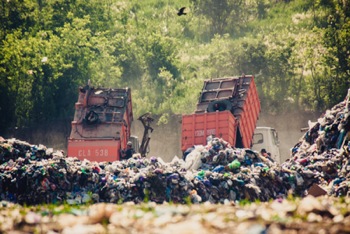
Living in the vicinity of a poorly maintained landfill or hazardous waste site can cause serious health effects, especially in children.and to the elderly. Health effects from exposure to hazardous waste can include
cancer, birth defects, low birth weight
and
genetic mutations. Exposure to harmful chemicals leached from landfills can come from the air, soil and groundwater. Short-term exposures to elevated levels of ammonia and hydrogen sulfide in the air nearby a landfill
can cause coughing, nasal blockage, sleeping difficulties, weight loss, chest pain, aggravation of asthma, irritation of the eyes, nose, and throat, headache, nausea, and breathing difficulties. Decomposing materials in landfills leach harmful chemicals such as chlorides and heavy metals into the soil, which can then get picked up by rainwater and be distributed to the drinking water of people and animals.
According to the American Journal of Environmental Sciences, landfill leachate has been implicated in developmental anomalies, birth defects and surface and groundwater pollution worldwide. Health effects caused by a reduction in oxygen levels, brought upon by carbon dioxide and methane emissions from landfills which displace oxygen,
include a faster heartbeat and having to take deeper breaths, similar to the effects felt after vigorous exercise. A greatly reduced oxygen level, a level well below the normal level of 21% of the total air volume,
can cause reduced coordination, fatigue, nausea, vomiting, and unconsciousness, however, these effects have rarely been reported from landfills. Even the
burning of landfill gas can emit harmful chemicals into the air, such as vinyl chloride, benzene, dichlorethene, methylene chloride, tetracloroethene, trichloroethene, mercury and dioxin, which is highly carcinogenic.
Most of these chemicals
cause liver damage, lung damage and cancer, and are harmful to the nervous system and reproductive systems of human beings and animals.
Learn more.
Reduce Waste
Guide to Green Living

